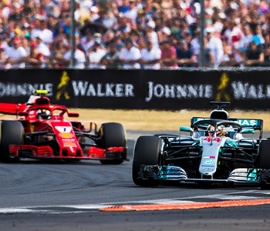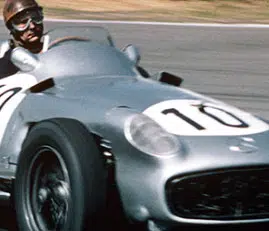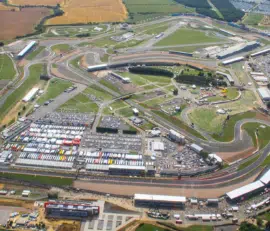From midday Saturday until 3 p.m. the pit area is complete chaos, with all the cars lined up in echelon in front of their pits, the faster cars at the beginning of the pits, the slower cars way up the other end, this being to avoid the really fast cars having to cover the whole length of the pit area when stopping during the race. During this initial three hours, cars are finally checked by the scrutineers, tanks are drained, refilled and sealed, pits are organised and a vast crowd mill about the cars. In spite of the fact that the paying public cannot get access to the pits the crowd on the track is enormous and walking from one end of the pits to the other one can almost guarantee to see everyone and anyone who is connected with motor racing. Even though a drizzling rain was falling, this year was no exception and it was like an annual garden party, which in fact the Le Mans race really is for everyone except the poor suffering drivers, mechanics and pit personnel.
Just before 3.30 p.m. the chaos reached untold heights, for after some 400 Vespa riders from all over Europe had gone past on a parade, followed by a very fine 1939 Le Mans Delahaye which was not supposed to have been there, the 55 competing cars had to be completely reshuffled, with the slow cars at the beginning of the pits and the fast ones right away at the far end, ready for the start. By 3.45 p.m. they were lined up in echelon with the DB4 G.T. Aston Martins at the head and the 701-c.c. Fiat-Abarths at the end.
Now that the cars were in position one could take final stock of the entry, and the accompanying race chart gives the driver pairings. Altogether there were five Aston Martins, the Essex Racing Stable of John Ogier fielding two G.T. cars, one driven by Fairman and the French rally driver Consten, and the other by the well-known Australians. Ogier also entered a DBR1/300 with new engine having the exhaust ports on the left instead of the right and an altered valve angle, this being number 4. The other sports Aston Martin was the old one of the Border Rievers. Number 1 was a white G.T. with Zagato bodywork as were the other two, driven by two Frenchmen. The American team run by Briggs Cunningham had three cars running, numbers 6, 7 and 24, comprising two of the latest Tipo 63 Maseratis with 3-litre V12-cylinder engines in the rear, all-round independent suspension, 5-speed gearboxes and tails covered in slots and louvres with four vast exhaust pipes sticking out of the top. These 12-cylinder engines were developments of the 1957 Grand Prix engine, with the inlet ports between the camshafts of each bank, a 60-degree vee angle, two plugs per cylinder and three double-choke downdraught Weber carburetters on each bank. Coil ignition was used, the distributors being driven from the train of timing gears and mounted in the vee of the engine. Cunningham had two versions of this engine, number 6 having a bore and stroke of 70 x 64 mm. and number 7 having 75 x 56 mm., both giving 2.9-litres capacity. Both cars were white with blue stripes, and the third car of this team was a 2-litre 4-cylinder front-engined Tipo 60, the original type of ” birdcage ” chassis Maserati; Briggs himself was co-driving this car, number 24. A third 12-cylinder Tipo-. 63 Maserati, with yet another bore and stroke variation of 68 x 68 mm., still giving 2.9-litres, was number 9, a Scuderia Serenissima entry, and they also had a rear- engined Fiat-Abarth Spider with 4-cylinder twin-cam engine of 701 c.c. which was number 8, and a Ferrari 250 G.T. number 16. All told there were eleven Ferraris competing and the factory had four of these. Numbers’ 10 and 11 were their main force, being front-engined V12-cylinder cars with all-round independent suspension, 1961 aerodynamic bodies with tail-” spoilers,” and six double-choke downdraught carburetters. Number 23 was a V6 rear-engined car of 2.4-litres, the 12-cylinder being 2.9-litres, and number 12 was a new 250 G.T. car using a sports six-carburetter Testa Rossa engine and having an even prettier and sleeker coupe body than the standard 250 G.T. Ferraris. The North American Racing Team, run by Luigi Chinetti, had five cars running, number 17 being a V12 sports car identical to the factory cars and being looked after by the factory pit staff. Number 18 was a brand new 250 G.T. painted in Rob Walker’s colours, with right-hand drive and being driven by Moss and G. Hill under the N.A.R.T. entry. Number 19 was another 250 G.T., American owned, and number 20 was a combined N.A.R.T. and E.N.B. entry; also run by N.A.R.T. was number 43, a small Osca, driven by Cunningham’s son. Number 21 was an Austin Healey 3000 hard-top looking truly ” Le Mans ” with fillets, bulges, louvres, lamps and bits and bobs all over it, entered by the Ecurie Chiltern. The Ecurie Ecosse had two entries, number 22 their Cooper-Climax, repaired after Nürburgring and using alloy wheels all round as the scrutineers would not allow different wheels front and back, unless two spares were carried, and a hard-top Austin Healey Sprite (number 46) with large Perspex wrap-round rear window made by Austins. The works twin-cam Triumphs, numbers 25, 26 and 27, were having their annual outing, showing every sign of good preparation and out to do a typical 24-hour endurance run rather than a cut-throat race, rather like Bristol used to do with their 450 coupes. Numbers 28 and 29 were true private-owners, being standard A.C. Ace-Bristols with hard-tops, the first a French entry and the second a Swiss one. The Porsche factory had four entries, numbers 30 and 32 being very beautifully finished coupes on the new 1961 RS chassis, having the roof cut-off short to form a rearward entry for cooling air and carburetter air for the flat-4 Spyder engines. These two cars had every appearance of prototype cars for next year’s G.T. racing and were as well finished inside the cockpit as a production Abarth Carrera. Number 33 was an open version of the 1961 RS model and Number 36 was a works Abarth Carrera. The French Porsche Agent entered number 37, another Abarth Carrera, painted blue and looking the nicer for it. Numbers 34 and 35 were the Rootes-entered Sunbeam Alpines, the first being a Harrington coupe conversion and the second a standard hardtop. Like the Triumph team they showed an air of detailed preparation for this event only with endurance rather than performance being the objective.





